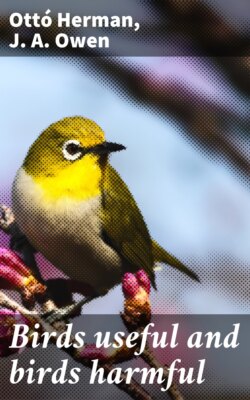Читать книгу Birds useful and birds harmful - J. A. Owen - Страница 12
На сайте Литреса книга снята с продажи.
The Little Owl.
(Athéne noctua.)
ОглавлениеTable of Contents
The Little Owl makes its nest where it has its ordinary dwelling-place; that is to say, in hollows, behind beams, sometimes even under bridges. The clutch of eggs is four to five, and they are almost perfectly round. The young are covered with white down.
This is a friendly little species; it likes to get under the house-roof, into barns and towers; retires also into the hollow of a tree and clefts in old masonry. A capital mouse-hunter, it feeds also largely on insects, and haunts the lawns to get out the earthworms. In winter it catches birds at roost, getting numbers of Thrushes, also mice and other small mammals. When the chase is prolonged till daylight the small birds mob the Little Owl, surrounding him in numbers. They dare not meddle with him because of his sharp claws, but they scold and chatter at him as a shameless thief. Bird-catchers profit by this, and they fasten him to a bough to act as a lure. There is in Hungary a superstition that no one dies where this Little Owl appears and utters his cry of Kooweek, kooweek! which comes down from the gables or the attic windows of the house.
The numbers of the Little Owl have been increasing in England of late. Mr. Meade-Waldo informed me that in the neighbourhood of Penshurst, near his own home, in Kent, he had seen as many as sixteen Little Owls perched on the telegraph wires on the line between two stations. This gentleman has always been known to be a lover and a protector of this species.
In Leadenhall Market there are often cages full of them which have been brought over from Holland. They make delightful house pets and good mousers indoors. “I have one of my own,” says A Son of the Marshes, “and I set him down as a bird of priceless value, for he has the power to make me laugh when I should be least in the mood for it.... Jan Steen and Teniers introduced him into their pictures. In that of ‘The Jealous Wife,’ for instance, there is the Little Owl perched on the window shutter contemplating an aged man holding sweet converse with a young woman, presumably his niece. The old woman, his wife, has also her head in the opening, taking in the scene wrathfully. My own bird is at liberty. This he uses to the best of his ability, making the third member of our small household.”
The Little Owl is about eight inches long, but seems bigger than it is because of its large head and soft plumage: its body is compressed in form. Bill and iris are yellow, legs clad with hair-like feathers, toes almost bare. The short tail is hardly visible beneath the points of the wings. The back is greyish-brown, spotted with white; the belly whitish, with long brown markings.
